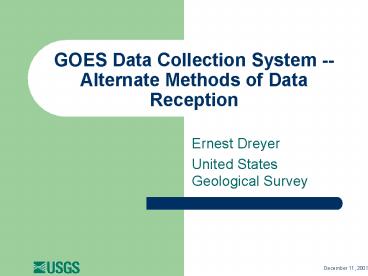GOES Data Collection System Alternate Methods of Data Reception - PowerPoint PPT Presentation
1 / 22
Title:
GOES Data Collection System Alternate Methods of Data Reception
Description:
United States Geological Survey. December 11, 2001. Overview. Current Methods of Data Reception ... This requires decoding software. ... – PowerPoint PPT presentation
Number of Views:48
Avg rating:3.0/5.0
Title: GOES Data Collection System Alternate Methods of Data Reception
1
GOES Data Collection System --Alternate Methods
of Data Reception
- Ernest Dreyer
- United States Geological Survey
2
Overview
- Current Methods of Data Reception
- Future Methods under consideration
- Some Problems and Solutions
3
Current Methods of Data Reception
- Direct connection to DAPS
- Direct Readout Ground Stations
- NOAAPORT
- DOMSAT and Local Readout Ground Stations
4
Direct Connection to DAPS
- DAPS supports
- A limited number of dial up connections
- Telnet and ftp connections using the internet
- Remarks
- User interface is a command-line, interactive
interface. - Useful for viewing or downloading small amounts
of data. - Unsuitable for real-time processing of large data
networks
5
Direct Readout Ground Station (DRGS)
- Ground stations that receive data directly from
the GOES satellite. - Current DRGSs receive data from GOES channels
using hardware demodulators - A demodulator can receive a transmission from a
single channel at any given time. - Thus, two DCPs transmitting at the same time on
different channels require two demodulators on
the DRGS
6
Direct Readout Ground Stations
7
Direct Readout Ground Stations (DRGS)
- Advantages
- Most direct method of data reception.
- Allows almost complete control of data collection
from field to users data processing system. - Considerations
- Initial cost and ongoing maintenance and support
of equipment. - Management of DCP assignments and channel
demodulators. - Data distribution and backup.
8
NOAAPORT
- Data distribution satellite operated by NOAA.
- Used by the NWS to distribute most NWS data
products. - Distributes all GOES DCS data on one of its four
channels.
9
NOAAPORT
10
NOAAPORT
- Advantages
- Well supported by many vendors making NOAAPORT
receive sites - Contains NWS products in addition to GOES DCS
data. - Considerations
- Cost and maintenance of equipment.
- Multiple failure points.
11
DOMSAT and Local Readout Ground Stations (LRGS )
- DOMSAT is a commercial satellite that is used to
distribute GOES data. - The entire GOES data stream is received at
Wallops Island by NESDIS and immediately
retransmitted to DOMSAT - Receive sites called Local Readout Ground
Stations(LRGS) have been developed to receive the
data from DOMSAT.
12
DOMSAT/Local Readout Ground Stations inUSGS
GOES Data Collection System
13
Local Readout Ground Stations
- Continuously receives all GOES data transmitted
from Wallops Island. - Supports various software packages that provide
- Network filtering to eliminate unwanted
transmissions. - Distribution of data over a network using
client/server protocols.
14
Local Readout Ground Stations
- Advantages
- Relatively inexpensive.
- No GOES demodulators to manage.
- Good network connection permitting good
capabilities for backup. - Considerations
- Relies on DAPS to transmit data to DOMSAT.
- Uses Ku-band which can degrade under certain
environmental conditions. - Footprint of DOMSAT is North America.
15
USGS Local Readout Ground Sites
- 19 LRGSs connected to the DOINET
- Each District has a primary and several secondary
LRGSs - Should a primary LRGS fail, a district is
automatically connected to a secondary LRGS
16
(No Transcript)
17
USGS and LRGS Software
- USGS has supported Software Improvements for
LRGSs - Developed software that runs on Linux
- The software supports
- Server/client protocol for the distribution of
real-time data - Network backup between LRGSs
- Network API using CORBA
- Software is written in C and Java
- Software is open source
18
Future Methods of Data Reception
- DRGS with hardware demodulators replaced with
software demodulators using digital signal
processing (DSP). - LRIT/EMWIN
- Likely replacement for DOMSAT
- Network Connection to DAPS ( DAPS II)
19
Some Problems and Observations
- No standard user reception interface for each of
the methods of distribution. - Each data reception method has a different
interface. - This makes difficult the sharing of data
reception devices for backups. - DAPS II will use client/server protocols similar
or identical to those developed for the LRGSs
which will make the LRGS client software usable
with both distribution systems.
20
Some Problems and Observations
- No standard method of decoding data.
- The small bandwidth of GOES does not allow the
transmission of meta-data that can completely
describe the transmitted data. - This requires decoding software.
- Various decoding methods have been devised and
are in use by different GOES reception devices. - This makes it difficult for users who share data.
21
USGS/COE Effort for Standardizing Site
Configurations
- Goal is to standardize decoding software for GOES
transmitters - Approach
- Use XML for metadata and decoding information
- Write decoding application in Java
- Publish the XML DTD as a standard for GOES
- Software developed is open source.
22
USGS/COE Decoding Software































